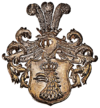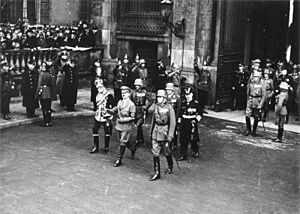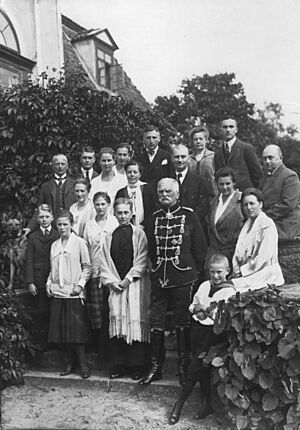August von Mackensen facts for kids
Quick facts for kids
August von Mackensen
|
|
|---|---|
 |
|
| Nickname(s) | "The Last Hussar" |
| Born | 6 December 1849 Haus Leipnitz, Province of Saxony, Kingdom of Prussia, German Confederation |
| Died | 8 November 1945 (aged 95) Habighorst, Province of Hanover, Allied-occupied Germany |
| Allegiance | |
| Service/ |
|
| Years of service | 1869–1920 |
| Rank | |
| Commands held | Army Group Mackensen |
| Battles/wars | Franco-Prussian War World War I |
| Awards | Grand Cross of the Iron Cross Pour le Mérite with Oak Leaves Order of the Black Eagle |
| Relations | Eberhard von Mackensen (son) Hans Georg von Mackensen (son) |
| Signature | |
August von Mackensen (born December 6, 1849 – died November 8, 1945) was a famous German field marshal. A field marshal is a very high-ranking army officer. He led a large group of soldiers called Army Group Mackensen during World War I (1914–1918). He was known as one of the best military leaders in the German Empire.
After the war ended in 1918, the winning countries held Mackensen in Serbia for about a year. He left the army in 1920. Later, in 1933, he became a special advisor in Prussia. During the time of Nazi Germany (1933–1945), Mackensen still believed in having a king or emperor. He often wore his old World War I uniform at official events. Some important Nazi leaders thought he might not be loyal to them, but they never proved anything against him.
Contents
Early Life and Army Start
August von Mackensen was born in a small place called Haus Leipnitz, near the village of Dahlenberg in Prussia. His father worked in farming. In 1865, August went to a special high school in Halle. His father hoped he would follow in his footsteps.
In 1869, Mackensen joined the Prussian army as a volunteer. He was part of the 2nd Life Hussars Regiment. Hussars were a type of light cavalry soldier. During the Franco-Prussian War (1870–1871), he became a second lieutenant. He earned the Iron Cross medal for bravely leading a charge during a scouting mission.
After the war, he left the army for a short time to study at Halle University. But he returned to his old regiment in 1873.
In 1879, he married Doris von Horn. Her father was an important official in East Prussia. They had five children together. Mackensen also found a helpful teacher in the War Minister, Julius von Verdy du Vernois. In 1891, Mackensen joined the General Staff in Berlin. This was a special group of officers who planned army movements. He got this job without the usual long training. His boss, Helmuth von Moltke, thought he was a "lovable character."
Mackensen was later called back to work for Alfred von Schlieffen, another important army leader. Mackensen learned a lot from Schlieffen about how to lead huge armies.
Mackensen made a good impression on Kaiser Wilhelm II, who was the German Emperor. The Kaiser gave him command of the 1st Life Hussars Regiment in 1893. Mackensen often wore their special uniform with a skull symbol. He was surprised when the Kaiser then made him his personal helper, called an adjutant. He was the first common person (someone not born into a noble family) to have this job. For over three years, he was close to the Kaiser and met many important people.
On the Kaiser's 40th birthday in 1899, August Mackensen was given a noble title. From then on, he was known as August von Mackensen.
After this, he led the Life Hussar Brigade from 1901 to 1903. Then, from 1903 to 1908, he commanded the 36th Division in Danzig.
His first wife died in 1905. Two years later, he married Leonie von der Osten. In 1908, Mackensen was given command of the XVII Army Corps. The Kaiser's son, the Crown Prince, was placed under his command. The Kaiser asked Mackensen to look after his son and teach him how to ride horses well.
First World War
Fighting on the Eastern Front
When World War I started in 1914, Mackensen was 65 years old. He was in charge of the XVII Army Corps. This group was part of the German Eighth Army in East Prussia.
Mackensen was very quick to act. On August 19, 1914, he received orders and had his corps marching within 50 minutes. They marched 25 kilometers (about 15 miles) to the Rominte River. This was after the Imperial Russian Army had entered East Prussia. He led his corps in important battles like Gumbinnen, Tannenberg, and the First Battle of the Masurian Lakes. These battles pushed the Russian soldiers out of most of East Prussia.
On November 2, 1914, Mackensen took command of the Ninth Army. On November 27, 1914, he received the Pour le Mérite medal. This was Prussia's highest military award. He earned it for his successful battles near Warsaw and Łódź.
By April 1915, Russian forces had taken over much of western Galicia and were moving towards Hungary. To help Austria, Germany decided to attack the Russian army. Mackensen was chosen to lead this combined German and Austro-Hungarian army. This new group was called Army Group Mackensen. It included a new German Eleventh Army and the Austro-Hungarian Fourth Army.
Mackensen's army had many more artillery guns. They broke through the Russian lines in the Gorlice–Tarnów Offensive. They kept moving east, not giving the Russians time to set up defenses. They took back most of eastern Galicia, including Przemyśl and Lemberg. This was a big victory for the Central Powers (Germany and its allies). They advanced 310 kilometers (186 miles), and the Russians soon left all of Poland.
Because of his success, Mackensen received more honors. He got oak leaves for his Pour le Mérite medal on June 3, 1915. He was promoted to field marshal on June 22. He also received the Order of the Black Eagle, which was Prussia's highest award for knights. He got many other awards from Germany and its allies.
Campaign in Serbia
In October 1915, Mackensen led a new Army Group Mackensen against Serbia. This army included German, Austro-Hungarian, and Bulgarian soldiers. The campaign defeated the Serbian army's main resistance. However, about half of the Royal Serbian Army managed to escape to ports in Albania. They were later helped by the French and Italians and rejoined the fighting on the Macedonian front.
When Mackensen returned to Vienna, he was honored by Emperor Franz Joseph I of Austria. He received a special medal with diamonds, which was very rare for someone from another country.
Mackensen seemed to respect the Serbian Army a lot. Before going to the Serbian front in 1915, he told his soldiers:
You are not going to the Italian, Russian, or French front. You are going into battle against a new enemy - dangerous, tough, fearless, and sharp. You are going to the Serbian front and Serbia. Serbs are people who love their freedom, and who will fight to the last man. Be careful this small enemy does not cast a shadow on your glory and compromise your successes.
Campaign in Romania

After Romania joined the war against Austria-Hungary in August 1916, Mackensen was given command of another army. This army had soldiers from Bulgaria, the Ottoman Empire, Austria-Hungary, and Germany. They gathered in northern Bulgaria and moved into Dobruja. By September 8, they had captured two important forts on the Danube River.
Then, another German and Austro-Hungarian army broke into Wallachia through the Carpathian Mountains. Mackensen's army crossed the Danube River. The Romanian Army and their Russian allies were caught between these two attacking forces. After three months, two-thirds of Romania was taken over by the Central Powers. The capital city, Bucharest, was captured on December 6, 1916, which was Mackensen's 67th birthday. He rode into the city on a white horse and moved into the Romanian royal palace.
For this success, Mackensen received the Grand Cross of the Iron Cross on January 9, 1917. He was one of only five people to get this high honor in World War I. Since he had now received every Prussian medal, the Kaiser decided to name a new type of warship, a battlecruiser, after him. Mackensen became the military governor of the part of Romania that the Central Powers occupied.
His last major battle was an attempt to destroy the Romanian Army, which had been reorganized. During the Battle of Mărăşeşti, both sides lost many soldiers. However, the Romanian Army won this battle. Mackensen always said he had never been defeated in battle. He was certainly one of the most successful generals on either side during World War I. By December 1917, the Russian Army had fallen apart. This forced the Romanian Army to sign a ceasefire, followed by a peace treaty.
On November 11, 1918, Germany signed an agreement to stop fighting with the Allies. This agreement meant that all German troops in Romania, the Ottoman Empire, Austria-Hungary, and Russia had to return to Germany. The Allies were also allowed to enter those countries.
After the War
After the war ended, Mackensen and his 200,000 soldiers were gathered up. He was arrested in Budapest by people working for the Hungarian leader. Mackensen was held in a guarded house. Later, he was handed over to the Allied army. He was a prisoner in Futog, Serbia, until November 1919. He was on a list of Germans accused of war crimes, but the accusations were eventually dropped.
By 1920, Mackensen had retired from the army. He did not like the peace treaty signed at Versailles or the new democratic government in Germany. At first, he stayed out of public life. But around 1924, he started using his image as a war hero to support groups who wanted a king or emperor back. He often wore his old Hussar uniform. He became active in groups that supported the military.
During the 1932 German election for president, Mackensen supported Paul von Hindenburg. He did not support Adolf Hitler, but he admired Hitler's political skills.
After Hitler came to power in January 1933, Mackensen became a public supporter of the Nazi government. He was a symbol of old Prussian traditions that Hitler's government wanted to show. He appeared in his black uniform at public events organized by the German government or the Nazi Party. In 1935, he stood with Hitler during a ceremony celebrating Germany's decision to openly re-arm, going against the Treaty of Versailles.
Mackensen's famous soldier look and his unique black Hussar uniform were even made into toy figures. His fame and uniform led to two different Nazi-era army groups using black uniforms with skull badges.
Even though he appeared with Nazi officials, Mackensen did not agree with everything the Nazis did. He was against the killing of some generals in 1934. He also did not like the Nazis' actions against churches or the terrible things that happened during the invasion of Poland in September 1939.
In February 1940, Mackensen wrote a letter to a general. In the letter, he expressed his concern about "crimes committed in Poland, looting and murder that take place before the eyes of our troops." He said these actions were harming the army's reputation and the nation's honor.
By the early 1940s, Hitler and Joseph Goebbels suspected Mackensen was not fully loyal, but they did not act against him. Mackensen remained loyal to the idea of a monarchy. In June 1941, he appeared in his full imperial uniform at Kaiser Wilhelm II's funeral in the Netherlands.
A news report from April 1945 said that Mackensen was briefly captured by the British army at his home during the end of World War II. When the British arrived, the 95-year-old Mackensen simply asked them to stop "freed foreign workers" from "stealing his chicken."
August von Mackensen died on November 8, 1945, at the age of 95. His life covered many different periods of German history. He was buried in the Celle cemetery.
Family
In November 1879, Mackensen married Dorothea von Horn (1854–1905). They had five children:
- Else Mackensen (1881/2–1888)
- Hans Georg von Mackensen (1883–1947), who became a diplomat
- Manfred von Mackensen (1886–1947)
- Eberhard von Mackensen (1889–1969), who became a high-ranking German Army general
- Ruth von Mackensen (1897–1945)
In 1908, after his first wife passed away, Mackensen married Leonie von der Osten (1878–1963).
Mackensen and his family were Lutheran Protestants.
Honors
- Grand Cross of the Order of Franz Joseph, 1900
- Pour le Mérite (military), November 27, 1914 – with Oak Leaves, June 14, 1915
- Grand Cross of the Military Order of Max Joseph, June 4, 1915
- Grand Commander of the Royal House Order of Hohenzollern, 1915
- Knight of the Order of the Black Eagle, August 1915
- Grand Cross of the Order of St. Stephen, September 1915
- Military Merit Cross, 1st Class with Diamonds, December 6, 1915
- Commander of the Military Order of St. Henry, 1st Class, December 6, 1915
- Grand Cross of the Iron Cross, January 9, 1917
- Iron Cross 2nd Class (1870 Version) with special oak leaves for the 25th anniversary of the Franco-Prussian War
- Iron Cross 1st Class (1914 Version)
- Grand Cross of the Order of St. Alexander, with Diamonds
- Grand Cross of the Military Order of Maria Theresa, March 26, 1918
- Order of Osmanieh, 2nd Class
- Order of the Medjidie, 1st Class
- Commander of the Merit Order of Philip the Magnanimous, 2nd Class
- Grand Commander's Cross of the Order of the Griffon
- Commander of the Order of the Zähringer Lion, 1st Class, with Oak Leaves
- Commander of the Order of the Württemberg Crown
- Knight of the Order of St. Anna, 1st Class
The University of Halle-Wittenberg gave him an honorary degree in Political Sciences. The Danzig University of Technology gave him the title Doktoringenieur (honorary engineering doctorate).
A type of battlecruiser, the Mackensen-class battlecruiser, was named after him. The first ship of this class, SMS Mackensen, was launched on April 21, 1917.
Mackensen was made an Honorary Citizen of many cities, including Danzig, Heilsberg, Buetow, and Tarnovo. In 1915, a new village in Pomerania was named Mackensen after him. Streets in various cities were also named after him. In 1998, a street in Berlin called Mackensenstraße was renamed.
See also
 In Spanish: August von Mackensen para niños
In Spanish: August von Mackensen para niños







